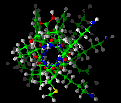 peek
peek peek
peek Jump to Description or
Examples; explanation of how
commands are documented.
Jump to Description or
Examples; explanation of how
commands are documented.
Keyword Values Default Meaning
cpu*_time_step real 60.0 The time, in seconds, between successive writes of the .pek and .pcar files. A value of 0.0 indicates that the peeking is not dependent on CPU time intervals. iter*ation_step integer 0 The number of iteration steps between successive writes of .pek and .pcar files. A value of 0 indicates that the peeking is not dependent on iteration steps. pek*file Boolean true Specify whether a .pek file is to be written. car*file Boolean false Specify whether a .pcar file is to be written. file*name string "" Specify the .pek and .pcar filename prefix. A value of "" means to use run_name.pek and run_name.pcar.
 Jump to Syntax or
Examples
Jump to Syntax or
ExamplesThe peek command is useful for monitoring the progress of long Discover calculations, either by CPU time intervals or by number of iteration steps. It is used in a similar way to the print command with minimize and dynamics execute commands and is specified by the peek parameter of these commands. The default action for the peek command is to produce a file, run_name.pek, every minute of CPU time used during an iterative BTCL command. This file contains information about the stage of the calculation and important system statistics, such as the energy contributions and convergence (for minimizations). If the carfile parameter is set to true, a run_name.pcar file is also written, which contains the coordinates of the system so that you can visualize the system as it changes during the run. By using the iteration_step parameter you can follow the calculation on a step-by-step basis, which is particularly useful if you want to observe some particular change of state that may occur at some point before the end of the calculation. With iteration-based peeks, the .pek and .pcar files are always written for the first iteration, so that you can tell that a new minimization or dynamics calculation has started.
The peek command may also be controlled from outside the Discover program by means of .ipc files. An .ipc file, run_name.ipc, contains a simple one-line command, such as stop, detach, attach, pause, or resume, which is used by the Insight program to control background Discover jobs.
Here is more information on IPC, interprocess communication.
 Jump to Syntax or
Description
Jump to Syntax or
Description
BTCL > minimize peek = "peek cpu = 0.0 iteration = 10 -pek +car"This example of the peek command shows its use with a standard minimization run (all parameters at their default values). The peek parameter of the minimize command specifies that a peek command should be executed, which causes the system coordinates file run_name.pcar to be written out every 10 iteration steps during the minimization.
BTCL > dynamics peek = ""In this example, a standard dynamics simulation is run with the peek parameter set to "". This means that no peek command is called, and the peek mechanism is disabled. This is useful for long simulations on large systems, since the polling and execution of peek commands slows some calculations significantly, especially if the peek command is set to generate .pek and .pcar files frequently.
BTCL > cdlConfig peek cpu = 20.0 file = lookin BTCL > minimize BTCL > dynamicsIn this example a cdlConfig command is used to specify the default values for the peek command to generate lookin.pek files every 20 seconds of CPU time. Since the peek parameters for subsequent minimize and dynamics commands are not specified, this is the default peek action for these commands, i.e., both commands write to lookin.pek every 20 CPU seconds during their execution.
 Main
access page
Main
access page  Advanced-Use access.
Advanced-Use access.
 List of BTCL commands
List of BTCL commands
 output command
output command
 print command
print command
Copyright Biosym/MSI